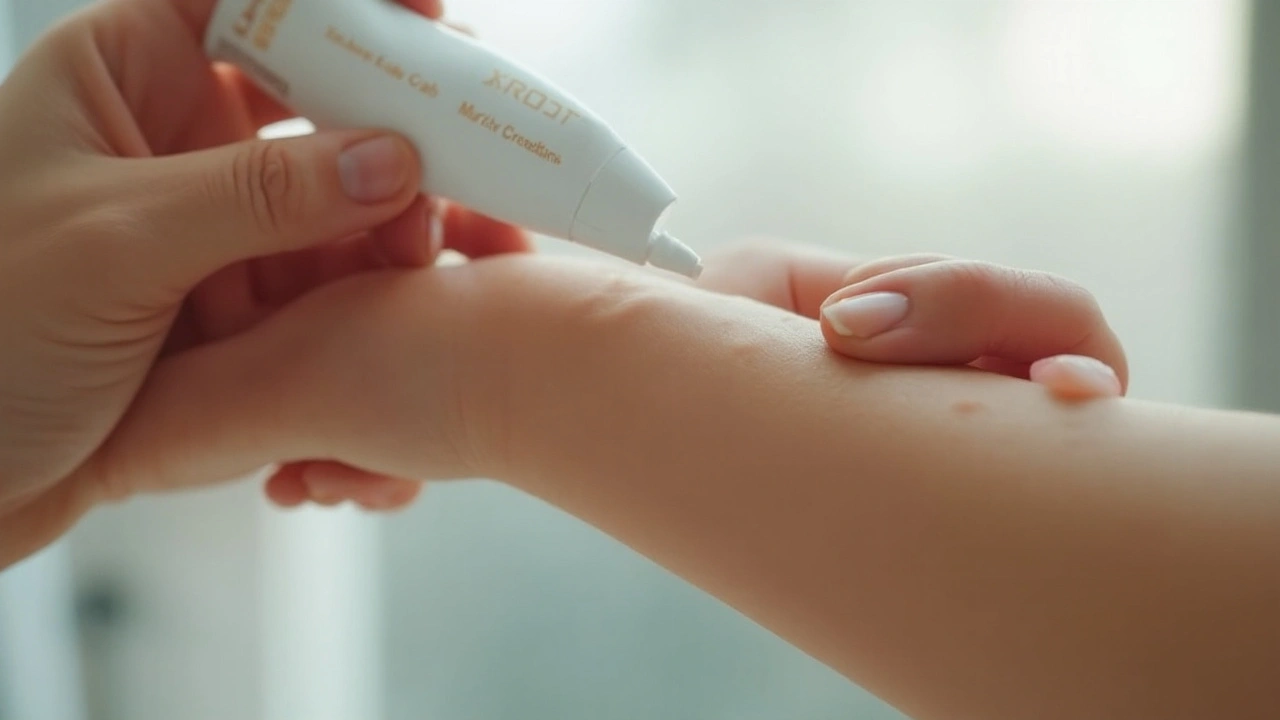TL;DR
- Aldara Cream contains imiquimod, a prescription topical that boosts the immune response to treat warts, actinic keratosis, and superficial basal cell carcinoma.
- Apply to clean, dry skin once daily (or as directed) and leave on for 6‑8 hours before washing off.
- Expect local skin reactions - redness, itching, or crusting - which are usually signs the medicine is working.
- Do not use on broken skin, open wounds, or if you are pregnant without medical advice.
- Check with a GP or dermatologist if symptoms worsen or you notice severe irritation.
What Is Aldara Cream?
Aldara is the brand name for a cream that contains imiquimod, a synthetic immune‑response modifier. It’s not an antibiotic or steroid; instead, it tricks the body’s immune cells into releasing interferon‑alpha and other cytokines that target abnormal skin cells. The result is a localized, controlled immune attack on the lesion.
In the UK, Aldara is prescribed for three main conditions:
- Genital and common warts caused by human papillomavirus (HPV).
- Actinic (solar) keratosis - rough, scaly patches that can become skin cancer.
- Superficial basal cell carcinoma (a low‑risk skin cancer).
The cream comes in 5% (standard) and 3% (lower‑strength) formulations, with the 5% version being the most widely used.
How to Use Aldara Correctly
Proper application maximises benefit and reduces unnecessary irritation. Follow these steps each time you use the cream:
- Wash your hands. Use mild soap, rinse well, and pat dry.
- Clean the treatment area with water (no harsh cleansers). Let it air‑dry.
- If you’re treating genital warts, ensure the area is completely dry before applying.
- Apply a thin film of Aldara - about the size of a pea - directly onto the lesion. Do not spread it beyond the borders.
- Using a disposable cotton swab can help keep the dose consistent.
- Leave the cream on for the prescribed time (usually 6‑8hours for warts, up to 24hours for actinic keratosis). Do not exceed the recommended duration.
- After the exposure period, wash the area gently with soap and water. Rinse thoroughly and pat dry.
- Wash your hands again to avoid accidental transfer.
Typical treatment courses last 4‑16 weeks, depending on the condition and how the skin responds. Your doctor will schedule follow‑up visits to monitor progress.
Common Side Effects and When to Seek Help
Because Aldara works by activating the immune system, skin reactions are expected. Most patients experience mild to moderate effects that fade after treatment stops.
| Side Effect | Typical Frequency | Management Tips |
|---|---|---|
| Redness / Erythema | 70‑90% | Cool compresses; avoid hot tubs. |
| Itching / Pruritus | 50‑70% | Gentle moisturiser (non‑fragrant) after washing. |
| Crusting / Scabbing | 30‑50% | Do not pick; keep the area clean. |
| Pain or burning sensation | 20‑40% | Apply a cold pack for 10min; discuss dose reduction with GP. |
| Flu‑like symptoms (fever, fatigue) | 5‑10% | Rest; if high fever persists, contact doctor. |
If you notice any of the following, stop using the cream and call your healthcare provider immediately:
- Severe swelling or blistering that spreads beyond the treated spot.
- Rapidly spreading redness or signs of infection (pus, foul smell).
- Allergic reactions - hives, difficulty breathing, swelling of lips or face.

Precautions, Contra‑indications, and Drug Interactions
Even though Aldara is applied topically, systemic absorption can occur, especially on large or broken skin surfaces.
- Pregnancy & breastfeeding: Safety data are limited. Discuss risks with a doctor before starting.
- Immunocompromised patients: Use cautiously; the immune boost might exacerbate underlying conditions.
- Concurrent topical meds: Avoid applying other creams, ointments, or soaps on the same area unless prescribed.
- Photosensitivity: Aldara can make skin more sun‑sensitive. Use sunscreen (SPF30 or higher) on surrounding skin during treatment.
Drug interactions are rare, but oral immunomodulators (e.g., interferon therapies) may increase the risk of systemic side effects.
What to Expect After Treatment Ends
Once the prescribed course finishes, most patients see a gradual fading of the lesion. In many cases, a small scar may remain, but it’s usually less noticeable than the original wart or keratosis.
Follow‑up appointments are essential. Your dermatologist may:
- Perform a visual check to confirm clearance.
- Take a biopsy if the lesion looks atypical.
- Recommend repeat treatment if new spots appear.
Long‑term skin health tips include regular sunscreen use, avoiding excessive sun exposure, and checking skin monthly for any new growths.
“Imiquimod (Aldara) remains a cornerstone in non‑surgical management of superficial skin cancers, provided patients adhere to the regimen and monitor for local reactions.” - British Association of Dermatologists, 2023 Guidelines
Frequently Asked Questions
- Can I use Aldara on my face? Yes, for actinic keratosis on the face, but apply a thin layer and be prepared for redness. A lower‑strength (3%) formulation may be recommended.
- How long does a typical wart take to disappear? Most genital warts clear within 6‑12weeks of daily use. Common warts on hands may need 12‑16weeks.
- Do I need a prescription? In the UK, Aldara is prescription‑only. A GP or dermatologist will assess suitability.
- Is it safe to use during a heat wave? Heat can intensify skin irritation. Keep the treated area cool and avoid excessive sweating.
- Can I shave the area after treatment? Wait until the skin has fully healed (usually 2‑3weeks post‑treatment) before shaving to prevent irritation.

Next Steps for You
If you suspect you have a condition that Aldara treats, book an appointment with your GP. Bring a list of any other skin products you use, and ask about the expected treatment timeline.
During your visit, discuss:
- Whether the 5% or 3% formulation is appropriate.
- How often you’ll need to apply it based on the lesion type.
- Any personal factors (pregnancy, immune disorders) that could affect safety.
Once you have the prescription, follow the application guide above, track any side effects in a simple notebook, and schedule your follow‑up as advised. With proper use, Aldara offers a non‑surgical, effective way to clear warts and precancerous skin spots.

12 Comments
Michael SegbawuSeptember 21, 2025 AT 20:25
This cream is just another $$$ scam the FDA lets big pharma push on us. I got warts from my ex and tried this crap for 3 months. Skin looked like a war zone. My buddy just had them frozen and it was done in 10 minutes. Why do we even need this?Also why is it called Aldara? Sounds like a brand of energy drink.
Aarti RaySeptember 23, 2025 AT 17:52
i used this in delhi last year for a wart on my finger after doctor said no laser cause too close to nailit burned so bad i cried but after 8 weeks it was gone
my mom said god bless science and i believe her
but dont use on face unless you like looking like a tomato
Alexander RolsenSeptember 24, 2025 AT 01:41
The data is misleading. 70–90% redness? That’s not a side effect-that’s a failure of the product’s design. If 9 out of 10 users experience severe inflammation, that’s not ‘working’-that’s a toxic irritant masquerading as immunotherapy. The FDA should have flagged this as a Class II hazard. And why is there no long-term study on cytokine overstimulation? This is just another example of pharmaceuticals prioritizing patent life over patient safety.Leah DoyleSeptember 25, 2025 AT 19:00
I used this for actinic keratosis on my nose and it was rough but worth it!My skin was red for like 2 weeks and I felt like a lobster but now it's smooth and I don't have to worry about skin cancer anymore.
Also I cried a lot during the first week but my cat slept on my arm so that helped lol 😭🐾
Alexis MendozaSeptember 27, 2025 AT 09:32
It's interesting how we treat skin like it's separate from the body. This cream doesn't just kill warts-it tells your immune system to fight. That's not medicine. That's asking your body to go to war. And maybe that's okay. But we should ask: why did the body let the wart grow in the first place? Maybe it's not just about the spot. Maybe it's about stress. Maybe it's about sleep. Maybe it's about not being heard.Michelle N AllenSeptember 28, 2025 AT 14:05
I read this whole thing and honestly I don't know if I should use it or not I mean I have this one spot on my neck that's been there for like 3 years and it's kinda flaky but I don't want to make it worse and I don't want to go to the doctor because they'll just charge me 200 bucks and tell me to use this cream anyway so I guess I'll just wait and see if it turns into something elseMadison MaloneSeptember 28, 2025 AT 16:15
If you're thinking about trying Aldara, just take it slow. Start with a tiny bit, maybe every other day, and give your skin time to adjust. I was scared at first too, but I kept a journal of how my skin felt each day and it helped me feel in control. You're not alone in this. I've been there. It gets better. And you're stronger than you think.Graham Moyer-StrattonSeptember 28, 2025 AT 19:51
Immunotherapy on a cream? Sounds like magic. It's not. It's just expensive inflammation. Stop glorifying it. Just cut it off.tom charltonSeptember 30, 2025 AT 05:34
Thank you for providing such a comprehensive and clinically accurate overview. The distinction between systemic and topical immune modulation is critical for patient safety, and your inclusion of follow-up protocols and contraindications demonstrates a high standard of medical communication. This is the kind of resource that empowers patients and reduces unnecessary anxiety.Jacob Hepworth-wainOctober 1, 2025 AT 17:28
I used this for a small basal cell on my ear and it worked. Took 12 weeks. Skin was raw but I didn't pick at it. My dermatologist said I did great.Just keep it clean and don't stress. It's not fun but it's not forever. You got this.
Craig HartelOctober 3, 2025 AT 15:46
My cousin in Arizona used this for a wart on her toe and now she says she feels like a superhero. Like she beat skin cancer with a cream from her bathroom. I think that’s kinda beautiful. Also she makes her own tea now and says it helps the healing. Maybe it’s the calm. Maybe it’s the cream. Maybe it’s both. Either way, she’s happy.Chris KahanicOctober 3, 2025 AT 21:57
The documentation is thorough. However, the absence of comparative efficacy data against cryotherapy or photodynamic therapy limits clinical utility. For patients seeking minimal intervention, surgical excision remains the gold standard for definitive removal. Topical immunomodulators should be considered in cases where surgical access is limited or patient preference dictates non-invasive management.